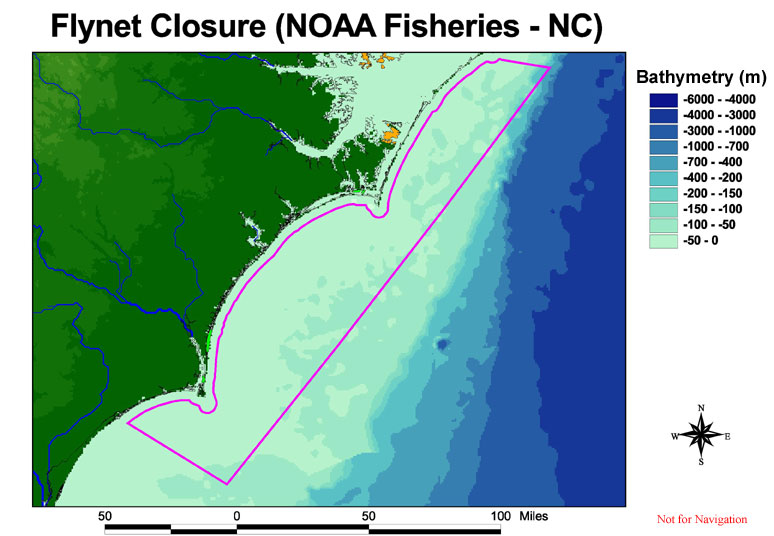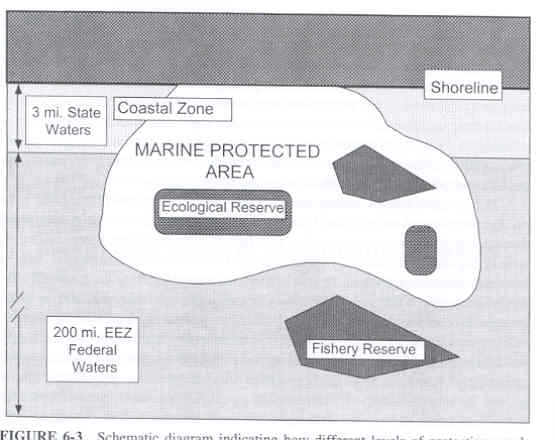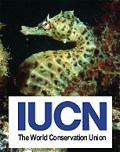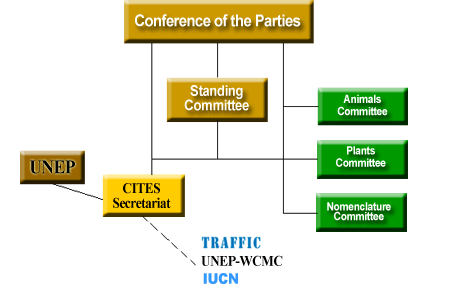
Seahorse Conservation Policy
Specific habitats and individual species can only receive total protection by being listed under a conservation policy or protected by law. Conservation policies are created by the combined efforts of policy makers, scientists, and local constituents. This section will discuss how various policies are created to protect seahorses and marine habitats in general. Primary sources of marine conservation policy are Marine Protected Areas (MPA), the Convention on International Trade on Endangered Species of Wild Fauna and Flora (CITES), and the International Union for Conservation of Nature and Natural Resources (IUCN).
Marine Protected Areas (MPA) are areas of ocean that are protected by legislation from some or all human activities (17). This includes activities such as commercial fishing, recreational fishing, oil drilling, bottom trawling, and coral harvesting. The most common definition of an MPA is provided by the IUCN as "any area of inter-tidal or sub-tidal terrain, together with its overlying water and associated flora, fauna, historical, or cultural features, which has been reserved by law or other effective means to protect part or all of the enclosed environment" (13). Figure 1 is an an example of an MPA off of the North Carolina coast that has been closed to Fly Net fishing by the authority of the Atlantic Coastal Fisheries Cooperative Management Act (34). MPA's can very in size from as large as hundreds of square miles like Figure 1 shows, to as small as one square mile. Over 20 nations have implemented marine reserves, however, currently less than 1% of the world's oceans are protected as MPAs, and less than one-hundredth of 1% are designated as marine reserves (5). Under the 1972 National Marine Sanctuaries Act, the U.S. has designated over 18,000 square miles of open water and coastal habitat as MPAs (5).
Figure 1

The history of MPA's goes far back. Although not called MPAs then, the first marine areas set aside for conservation were created by chiefs who felt that an area had been over-fished. Interestingly enough, the first official MPAs came about after the observed increase in fish stocks in the North Sea after World War II, when certain fishing grounds were inaccessible due to the presence of mine fields (17). In 1958, four conventions known as the Geneva Conventions on the Law of the Sea were adopted; this was the first step in establishing an international framework for protection of living marine resources (17). Since then, there have been two more Conventions on the Law of the Sea which have increased the obligations of nations to create MPAs for the conservation of biological diversity and productivity. It is worth noting that the United States has not ratified either convention, however, they have taken their own steps in enacting legislation relative to the designation and management of marine protected areas.
Depending on their purpose, an MPA can be designed for one or more of the following purposes: to increase reproductive potential, maintain species diversity, preserve habitat, preserving ecosystem function, and supporting fisheries (17). These objectives allow MPAs to conserve habitat, promote ecotourism, and serve as an educational resource to the public (2). MPAs that have multiple-use zoning serve more than one purpose and are the most prominent types (Figure 2).
Figure 2 (17)
 MPAs
are implemented by regional, state, and local entities, as well as by grassroots
campaigns, and top-down governmental legislation. Special interest
groups such as the Sierra Club and Project Seahorse, are strong lobbiest
for the implementation of MPA's in the world's most vulnerable habitats
(5). Since MPAs limit the use of marine habitats
their implementation requires the involvement and participation of local
fishers, environmental
groups, management agencies, and scientists to provide sufficient input
for success. There are many differing opinions
and
self interests within these groups, and often times
the
implementation
of
an MPA
is a
long and bitter process. Figure
3 shows three different methods involving input from many groups to reach
a final decision for an MPA.
MPAs
are implemented by regional, state, and local entities, as well as by grassroots
campaigns, and top-down governmental legislation. Special interest
groups such as the Sierra Club and Project Seahorse, are strong lobbiest
for the implementation of MPA's in the world's most vulnerable habitats
(5). Since MPAs limit the use of marine habitats
their implementation requires the involvement and participation of local
fishers, environmental
groups, management agencies, and scientists to provide sufficient input
for success. There are many differing opinions
and
self interests within these groups, and often times
the
implementation
of
an MPA
is a
long and bitter process. Figure
3 shows three different methods involving input from many groups to reach
a final decision for an MPA.
The most successful MPAs are those that have strong community involvement. It has been noted that community-based management of an MPA has the advantage over government based management because: 1. they have some rights (formal or informal) in the involved coastal marine ecosystem; 2. they have useful knowledge about the coastal marine ecosystem; 3. they have personal or group resources that are needed for the MPA's operation; 4. their absence could destroy or undermine the integrity of the MPA if they are not involved in its establishment and management; and 5. they will support and enforce the rules of the MPA if they are involved (18).
Figure 3
The implementation of MPAs is a process which takes much thought and understanding of marine conservation science. Too often a "one-size-fits-all" design is created, but because every MPA is different it requires different methods of management and design, therefore these cookie cutter methods of design fail. A successful MPA will succeed in fisheries management, safeguard ecosystem health and biodiversity, and lead the way for future MPAs to be implemented (21).
 The
IUCN is an organization whose aim is to conserve nature by providing a legitimate
source of information pertaining to endangered species. The IUCN
is a
large organization with many member countries. It's constituency
includes some 140 countries, 70 States, 100 government agencies, and over 750
NGOs (34). The IUCN's mission is to get countries
to apply sustainable management methods to all their natural resources in order
to conserve endangered species, including everything including endangered plants,
animals, and marine organisms. This organization which
is part of the World Conservation Union assesses the conservation status of
species,
subspecies, varieties, and subpopulations on a global scale in order to identify
which species could be threatened with extinction. These species are then placed
in certain categories in the IUCN Red list indicating their risk
of extinction on the global scale. The categories are, extinct (EX), extinct
in the wild (EW), critically
endangered (CR), endangered (EN), vulnerable (VU),
near threatened (NT), least
concern (LC), data deficient (DC), and
non-evaluated (NE) (34).
The
wide
spectrum of taxa and the inherit uncertainties that accompany
estimates on the global scale effect the accuracy of the IUCN Red List. However,
this list is a helpful
tool
in
the development of
MPA's by showing which countries
are and are not
doing
a good
job
preserving
their biodiversity. Countries with high numbers of endangered
species
often face international pressure from other countries and NGOs, which demand
a strong response for the preservation of their
endangered
species.
The
IUCN is an organization whose aim is to conserve nature by providing a legitimate
source of information pertaining to endangered species. The IUCN
is a
large organization with many member countries. It's constituency
includes some 140 countries, 70 States, 100 government agencies, and over 750
NGOs (34). The IUCN's mission is to get countries
to apply sustainable management methods to all their natural resources in order
to conserve endangered species, including everything including endangered plants,
animals, and marine organisms. This organization which
is part of the World Conservation Union assesses the conservation status of
species,
subspecies, varieties, and subpopulations on a global scale in order to identify
which species could be threatened with extinction. These species are then placed
in certain categories in the IUCN Red list indicating their risk
of extinction on the global scale. The categories are, extinct (EX), extinct
in the wild (EW), critically
endangered (CR), endangered (EN), vulnerable (VU),
near threatened (NT), least
concern (LC), data deficient (DC), and
non-evaluated (NE) (34).
The
wide
spectrum of taxa and the inherit uncertainties that accompany
estimates on the global scale effect the accuracy of the IUCN Red List. However,
this list is a helpful
tool
in
the development of
MPA's by showing which countries
are and are not
doing
a good
job
preserving
their biodiversity. Countries with high numbers of endangered
species
often face international pressure from other countries and NGOs, which demand
a strong response for the preservation of their
endangered
species.
The IUCN posts what species are endangered, however, it does not restrict their
trade in the profitable global market for exotic species. CITES, the Convention
on International Trade in Endangered Species of Wild Fauna and Flora is an agreement
between governments which pledges to reduce the trade of wild plants and animals
in order to preserve their survival. CITES came about during the 1960's to regulate
the trade of Africa's game animals (30). Today,
the wildlife trade is worth billions of dollars, and consists not only of wild
animals and plants, but the products that can be derived from them, such as
seahorses in the Chinese Medicinal Market. The current list covers over 30,000
species of plants and animals.
CITES is a voluntary agreement between countries. Once a country has agreed
to join CITES, they are known as Parties, which means they are legally bound
to the agreement requiring legislation that implements the restriction on the
trade of endangered wild plants and animals (30).
Presently, there are 163 parties involved in CITES. The framework of CITES demands
that all import, export, re-export, and introduction of any of the species listed
by the Convention need be authorized through a licensing system. Parties must
abide by three appendices, provided by CITES, which offer the degree of protection
that certain traded animals need. Appendix I includes species that are threatened
with extinction, therefore trade is only permitted in exceptional circumstances.
Appendix II includes species not necessarily threatened with extinction, but
in which trade must be controlled in order to avoid extinction. Appendix III
contains species that are protected in at least one country, which has asked
other CITES Parties for assistance in controlling their trade (30).
Since the creation of CITES not one species protected by its agreement has gone
extinct.
Figure 3
 The cooperation between CITES and IUCN has brought about a drastic change in
marine governance (Figure 3). With seahorses listed on both the IUCN Red List
and CITES Appendix III, the seahorse is now being protected worldwide. Since
their extraction is being more closely monitored, countries are paying more
attention to sustainable methods of extraction. This means there is more education
and funding going towards poor farmers who rely on these fish for a living.
In conclusion, this is the first time in a while that the world has taken a
step forward in the conservation of an endangered species, without taking a
step back first.
The cooperation between CITES and IUCN has brought about a drastic change in
marine governance (Figure 3). With seahorses listed on both the IUCN Red List
and CITES Appendix III, the seahorse is now being protected worldwide. Since
their extraction is being more closely monitored, countries are paying more
attention to sustainable methods of extraction. This means there is more education
and funding going towards poor farmers who rely on these fish for a living.
In conclusion, this is the first time in a while that the world has taken a
step forward in the conservation of an endangered species, without taking a
step back first.
Framework of CITES provided by CITES.org
Back to Top
See California's Marine Life Protection Act, a functioning MPA, here.